While you wouldn't say so at first glance, BIOS was developed by me, as an elaborate scheme to enhance sports performance. Everything was tested by me in the field, from dry theory to competitive action. I have often found that enhancing sports performance translates into quick hacks that are relevant to longevity too.
Ergogenic Function Of Hydrolysate Proteins
BIOS uses essential amino acids (powder) as the main supplemental method to reap sufficient protein. But, protein from foods can have additional benefits for recovery and anti-inflammation. Because hydrolyzed protein powders seem to contribute beneficial bioactive peptides (1) that aid both recovery and endurance performance, in addition, some will contain residues of phytochemicals that still deliver a significant amount of beneficial substances for example polyphenols.
For example, isolated soy protein (ISP) contains naturally occurring compounds, including isoflavones and saponins that possess anti-oxidative, antiinflammatory, immune-regulatory, anti-carcinogenic, and cardio-protective influences not present in EAA. As mentioned before, hydrolyzed protein powders contain bioactive peptides, which are formed during the hydrolysis process. These peptides can have various biological activities, such as improving immune function, enhancing mineral absorption, and potentially having beneficial effects on blood pressure and cardiovascular health. So you want the powders that ironically are processed to a greater degree (hydrolysation) than others, you want a soy hydrolysate and not the isolate. You can consider this as a sort of pre-digestion that yields peptide bonds with health benefits, now available to your body that wouldn’t have been without the process.
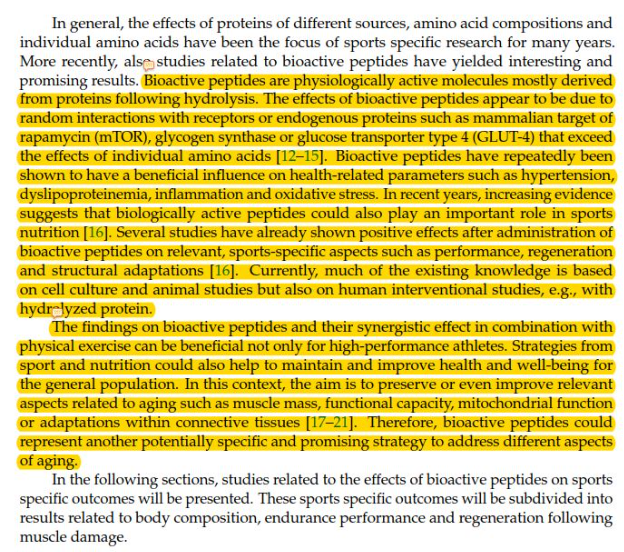
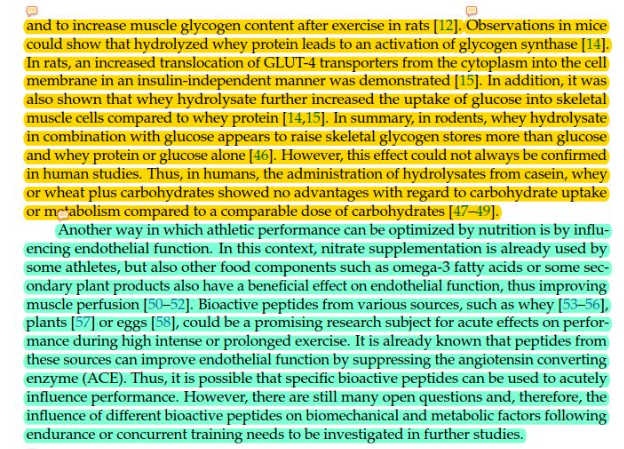
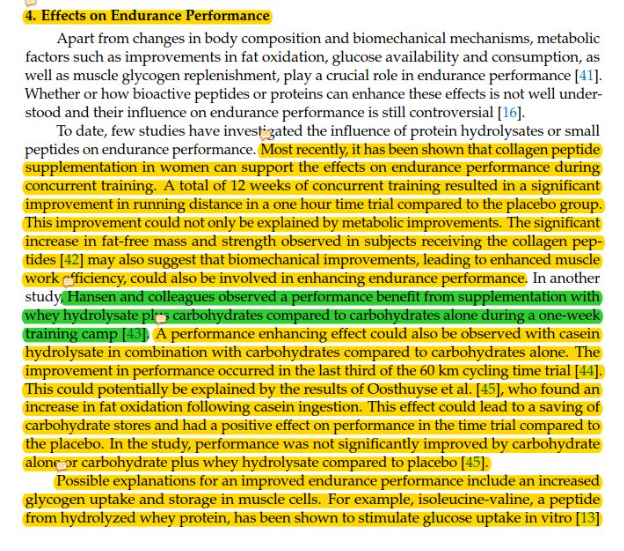
This all might translate into a better performance during match time, the peptides might contribute to increased nitric oxide levels through ACE, benefitting endothelial function. Might spare glycogen stores, and lower inflammation, and oxidative stress.
Could use whatever hydrolysate of choice, whey, casein, soy, beef, hemp… Even without hydrolysation, something like isolated soy protein still delivers some of the nutritional health benefits related to whatever food they were distracted from. I have at one time swapped my EAA shake with a soy protein isolate during noon, and believe it to have contributed to better match performance in the evening.
In this RCT (2), well-trained athletes ingested 25 grams of ISP x2 daily. Markers of inflammation, muscle damage, & oxidative stress were all lower in the ISP group. Furthermore, ISP showed a positive ergogenic effect on heart rate response in all participants. ISP = amino acids + antioxidants.
In a 2010 study (3) with an experimental design that could be relevant to soccer gameplay dynamics, adding ISP to a shake with carbohydrates caused an ergogenic effect in endurance capacity close to 10%.
-
Use a food-based protein powder (that is not EAA powder)
-
Choose a hydrolysate form (bioactive peptides)
-
A plant-based protein powder will contain considerable phytochemical residue which can be ergogenic in turn (not saying animal-based protein powders don’t deliver antioxidants though)
-
Food-based protein powders have non-essential amino acids (missing in EAA powders) that can enhance recovery
-
For BIOS, it’s AND / AND : both EAA and food-based hydrolysates.
-
I like soy hydrolysate because it reaps additional polyphenols, therefore this is the quickhack going to the checklist
SOURCES
(1) König, D., Kohl, J., Jerger, S., & Centner, C. (2021). Potential relevance of bioactive peptides in sports nutrition. Nutrients, 13(11), 3997.
(2) Shenoy, S., Dhawan, M., & Sandhu, J. S. (2016). Four weeks of supplementation with isolated soy protein attenuates exercise-induced muscle damage and enhances muscle recovery in well-trained athletes: a randomized trial. Asian Journal of Sports Medicine, 7(3).
(3) Ghosh, A. K., Rahaman, A. A., & Singh, R. (2010). Combination of sago and soy-protein supplementation during endurance cycling exercise and subsequent high-intensity endurance capacity. International journal of sport nutrition and exercise metabolism, 20(3), 216-223.
An Extra Protein Shake 2-Hours Before Performance
Normally, I don't "waste" EAA shakes before training, as per Dr. Robert Wolfe, the EAA would just be burned as fuel during endurance work. Yet looking at the literature, that might not be a bad thing for performance
A meta-analysis (1) in 2010 reported a similar finding from the soy study mentioned earlier, a ~10% increase in performance supplementing protein & carbs compared to carbs alone. That's massive for athletes considering that a 1% improvement could have been the difference between the gold and silver medals in the 2016 Olympic Games men’s marathon in Rio. Part is from more calories (though EAA has few) yet 3.4% is from protein actions. We can thus improve performance (as measured by time to exhaustion) with this extra protein shake beyond simply the provision of its extra calories.
Amino acids are speculated to have a glycogen-sparing effect during exercise, they can also enhance intestinal fluid uptake for rehydration and the BCAA's in the protein may improve time trials, peak power, and immune health & lower central fatigue via serotonin. These benefits carry over to post-workout conditions where there’s a greater glycogen replenishment lower damage levels and increased recovery rate.
- Consuming protein in your pre-workout (2h) shake could in theory increase performance anywhere near 3.4-10%.
SOURCES
(1) Cintineo, H. P., Arent, M. A., Antonio, J., & Arent, S. M. (2018). Effects of protein supplementation on performance and recovery in resistance and endurance training. Frontiers in nutrition, 5, 83.
BIOTOSHI’S TRYPTOPHAN PERFORMANCE QUICKHACK

Dr. Robert Wolfe doesn't add tryptophan to his amino acid formulations because he fears athletes will become sleepy. But I have found that tryp could ironically be improving exercise performance.
I myself discovered the quirks of tryptophan while experimenting with supplementing whey protein isolate that I was testing for the benefits regarding peptides. I took 1/4-1/3 cup in the evening and suddenly got very sleepy. What could have caused this effect from whey?
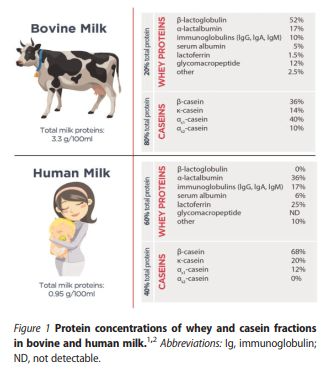
Turns out, whey has a molecule named a-lactalbumin (Alpha-La), and it is composed of a high level of tryptophan, while present in bovine milk, human milk contains twice the amount of alpha-lactalbumin, and is believed to help the baby fall asleep after drinking milk. As I went further into this rabbit hole, I found that it was an actual baby formula addon. Agropur’s BiPRO® Alpha 9000 is the purest isolated form of alpha-lactalbumin (90% of protein) commercially available and allows infant formula manufacturers to create products that more closely resemble breast milk.
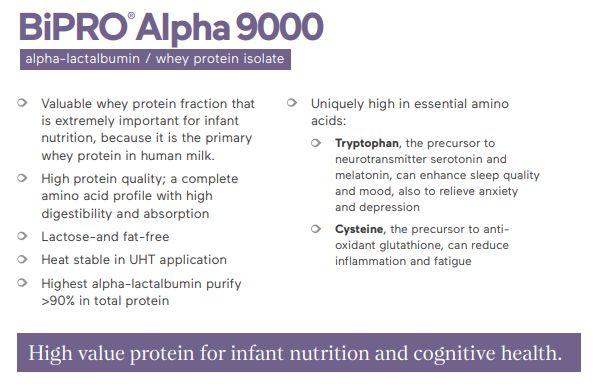
Alpha-lactalbumin is exceptionally high in tryptophan. It contains about 14% tryptophan by weight of the protein, which is significantly higher than most dietary proteins. To get an idea, these are the highest food sources: whey, eggs, soybeans, natto, turkey, meat, and chicken, and commercial EAA powders, these all reap between 1 and 1.5% tryptophan by weight of protein with a comparable ratio between different proteins. It is generally accepted that these food sources high in tryptophan (like turkey) don't make you fall asleep.
“To get into the brain amino acids must be shuttled across the blood–brain barrier by specialized transport proteins. Like passengers trying to board a crowded bus, amino acids compete for rides on these transporters. Not only does tryptophan have paltry representation among the passengers; but it also competes with five other amino acids for the same transporter. Aced out by other amino acids, tryptophan thereby has a tough time hitching a ride to the brain.”
Tryptophan is always the limiting amino acid in nature, it is represented in the lowest quantity as compared to other AAs in foods. Tryptophan, along with these other amino acids, belongs to a group known as the large neutral amino acids (LNAAs). The specific amino acids that compete with tryptophan for transport across the blood-brain barrier are:
-
Leucine (EAA)
-
Isoleucine (EAA)
-
Valine (EAA)
-
Tyrosine (NEAA)
-
Phenylalanine (EAA)
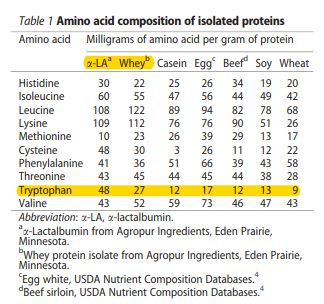
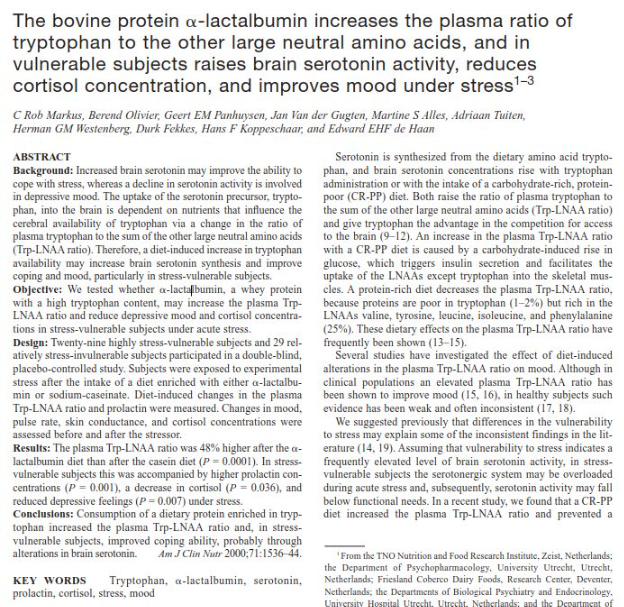
When you bump the serum Trp-LNAA ratio, more tryptophan will cross the blood-brain barrier, and serotonin concentrations in the brain will rise produced by serotonergic neurons. This is why consuming foods high in tryptophan relative to other amino acids, can be a strategy to potentially influence brain serotonin levels. Furthermore, serotonin is a precursor to melatonin. In the pineal gland, after darkness, serotonin is acetylated and then methylated to become melatonin.
Looking at the sales sheet of Bipro Alpha 9000 again:
-
Rich in tryptophan, a precursor to serotonin and melatonin that can improve sleep quality, and relieve anxiety and depression.
-
Rich in Cysteine, a precursor to the most important anti-oxidant glutathione
The cysteine in itself is very interesting, but we’ll keep this for another article. The indole tryptophan is a precursor to serotonin, melatonin, and NAD+ and is massively important for the benefits of exercise via the KYN pathway, but again, this is for another article.
The Alpha-LA has a twofold effect on sleep quality, we should make this distinction now.
1) Long-Term Effect: Raises serotonin synthesis in the brain during the day, this extra serotonin will be acetylated to melatonin by the pineal gland in the evening which will benefit sleep onset and quality at night. The extra serotonin will also increase relaxation and mood in the evening which can again benefit sleep onset and duration.
2) Acute Effect: Serotonin can enhance relaxation but also cause drowsiness. (“helps the baby fall asleep after milk”).
Higher brain levels of serotonin are one aspect believed to be causing something named “central fatigue” in sports science, an effect encountered after prolonged exertion. This is why Dr. Robert Wolfe thinks adding tryptophan to a pre-workout shake can cause “sleepiness” acutely.
Central fatigue is thought to be caused by several factors, including:
-
Increased levels of serotonin:* Serotonin is a neurotransmitter that is involved in feelings of relaxation and drowsiness. During prolonged exercise, serotonin levels in the brain increase, which can lead to feelings of fatigue and decreased motivation.*
-
Decreased levels of noradrenaline and dopamine:* Noradrenaline and dopamine are neurotransmitters that are involved in the regulation of alertness and motivation. During prolonged exercise, levels of noradrenaline and dopamine in the brain decrease, which can lead to feelings of fatigue and decreased motivation.*
-
Increased core body temperature:* Core body temperature increases during prolonged exercise, which can lead to impaired cognitive function and reduced motivation.*
-
Dehydration:* Dehydration can also contribute to central fatigue by impairing blood flow to the brain and reducing the delivery of oxygen and nutrients.*
Yet, as we previously discussed, Alpha-LA doesn’t cause sleepiness acutely (in the absence of darkness and pineal gland activity), it only causes potential drowsiness. But Alpha-lactalbumin is the odd one out, with 14% of its protein being tryptophan, any other normal source of food or protein powder has 800-1600% less tryptophan in it.
So why do I include tryptophan in my pre-workout again?
In 1988, Ventura tested Tryp in sportsmen doing strenuous exercise to failure and found a 50% 🤯 increase in exercise time vs the placebo.

Ventura called tryptophan the “endogenous opioid system”. While tryptophan itself is not an opioid peptide, it indirectly influences mood and can contribute to feelings of well-being and relaxation through its role in serotonin synthesis. Serotonin, in turn, can influence the release of endorphins and other neurotransmitters that contribute to mood regulation and pain perception.
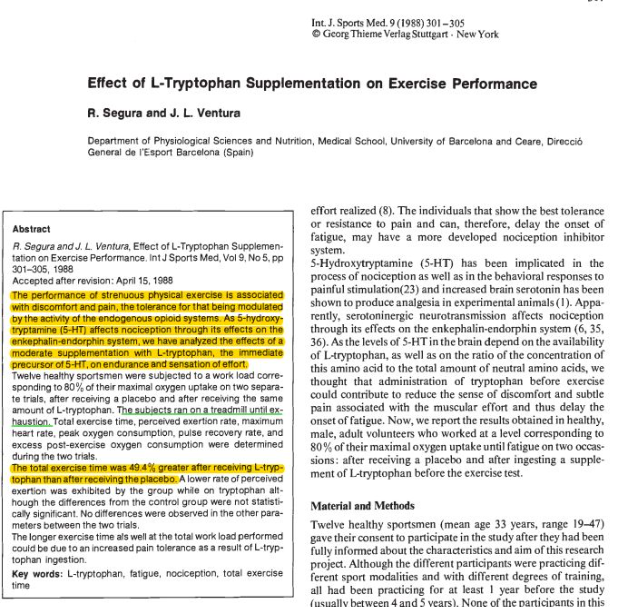
Ventura used 150 mg (isolated) tryp twice the day before the exercise, and thrice on the day of exercise, with the last dose 1h before exercise. He speculates that this enables a super effort modus, a state of sustained effort that temporarily overcomes fatigue and pain. Both are very important factors during all-out physical exercise.

In 2010, Javierre more or less replicated these findings in a cross-over, double-blind, randomized protocol. With exercise that closely mimics team sports and 600mg TRYP daily with one dose, 2h before exercise.
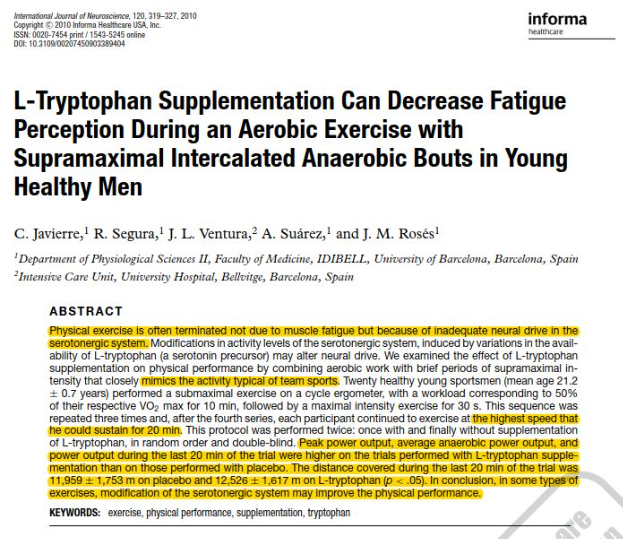
Again, L-tryptophan supplementation substantially improved physical performance during aerobic exercise.
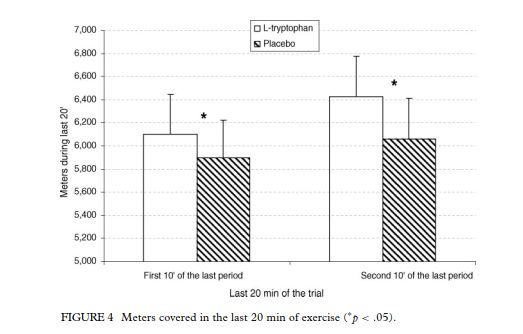
In 2019, an article was published by Ignasi reporting on a double-blind crossover trial on elite cyclists with results consistent with those observed by Ventura and Javierre. The same dose as the previously mentioned studies (10mg/BW kg) was used in the last 30min. before exercise.
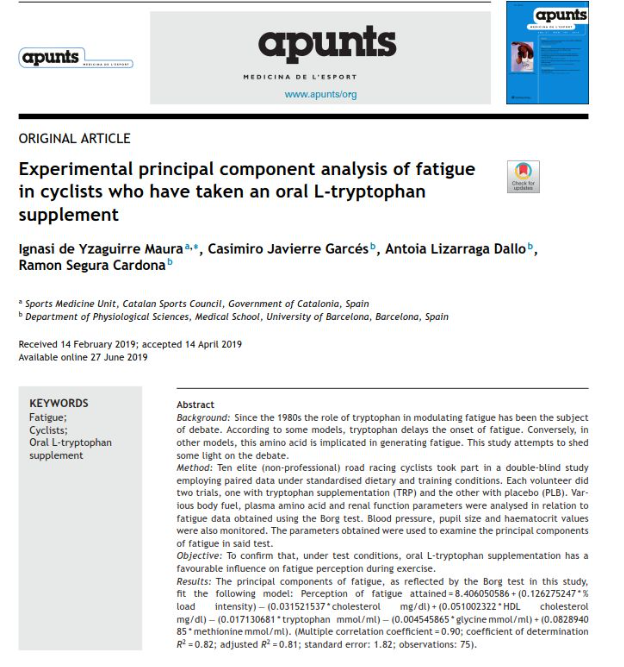
Ignasi did give the entire daily dose as a pre-workout though and reports; "The Tryp was rapidly absorbed and within half an hour of its ingestion, plasma tryptophan levels were 4-fold higher, and 3h later those levels were still 3 times higher than normal."
Endorphins are a type of endogenous opioid that is released in response to pain. They are also released during exercise, sex, and other pleasurable activities. Endorphins are thought to be responsible for the "runner's high" and other feelings of euphoria. Apparently, your pupils widen after Tryp supplementation because of its role in the endogenous opioid release. Tryp seems to be glycogen-sparing and might enable enhanced use of triglycerides as fuel. Ignasi reports that some of that TRYP also made its way into the brain.
But rather than causing sleepiness, higher levels of Tryp prevent the decline of Tryp typically seen during exercise and in doing so prevent neuronal insufficiency.
This is highly relevant for team sports like soccer, or whichever all-out exercise types are limited by “pain” or the perception of exhaustion rather than pure energy depletion. If you want to understand more about this, I recommend reading Alex Hutchinson's book; "Endure; Mind, Body, and the Curiously Elastic Limits of Human Performance".

It looks like the theory of central fatigue as we know it, requires an update. Ignasi concludes.

If TRYP increases performance, shouldn't alpha-lactalbumin be at least equally effective (1)? Well, maybe, but we don't know because these authors used it in the wrong exercise context (a 21km run) and compared it to whey, which also has it. Fatigue & cortisol were lowered, though.
This new evidence also highlights that the fear of acute drowsiness hampering sports performance is unfounded. The exercise itself depletes tryptophan, possibly serotonin. The benefits from Tryp for time to exhaustion range from highly relevant to "sensational" in the previously reported studies.
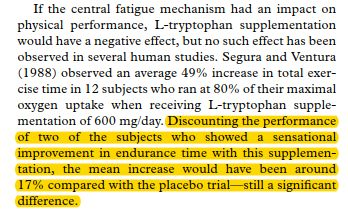
So what’s the takeaway from all of this madness?
It should be noted that I designed this quickhack and subsequent research by reverse engineering an experience I had on the football (soccer) field, where one day, I was receiving considerable verbal praise from multiple teammates including the coach for my performance on one hand and discovering that after this performance my normal calluses were no longer sufficient to withstand the increased maneuverability, which was reflected by a layer of blood beneath my big toe after directly after the session. (which also seems to hint at reduced pain perception). One of the things I (unknowingly) did differently on that day was to emulate the routines perfected by Ventura, Javierre, and Ignasi, by having a high tryptophan load that day. I had already taken 3 doses of EAA powder the day before, and on the day of the performance had two EAA shakes and a third EAA shake which I consumed as a pre-workout 2 hours before exercise. We’ve seen that commercial EAA powders fall in the range of high Tryp foods. While the studies used isolated tryptophan, my route would have (almost) contained the same amounts of Tryp overall. (360mg vs the 450mg minimal in the studies).
Let’s look at some possible conclusions.
-
a-lactalbumin (Alpha-La), a component of human and bovine milk is absurdly rich in tryptophan, a limiting amino acid in nature, which helps babies sleep after weening
-
normal foods high in tryptophan are whey, eggs, soybeans, natto, turkey, meat, and chicken, and commercial EAA powders
-
circulating serum tryptophan levels can be raised with these foods, bumping serotonin synthesis in the brain, acutely causing drowsiness, happiness, relaxation, and improving sleep and relaxation at night
-
we could in theory use an isolated source of tryptophan instead of food or Alpha-La via an L-Tryptophan supplement, which in modern times is considered to be safe
-
studies since the ‘80s have seen considerable improvements in exercise capacity, especially for time to exhaustion during tryptophan supplementation
-
the theory of central fatigue is probably no longer valid in its current form, tryptophan and serotonin play a major role in enabling effort through time through opioid-like mechanisms
-
the drowsiness accompanied by higher serotonin, need not take place in the context of exercise, which is a brain-tryptophan-depleting activity
-
a pre-workout routine that bumps circulating tryptophan levels can be distilled from this information
BIOTOSHI’S TRYPTOPHAN PERFORMANCE QUICKHACK
The studies mentioned use tryptophan in the range of 450 mg to 600 mg, with a last dose (150 mg) just before exercise. Most commercial EAA powders contain 9 grams of EAAs per scoop. This scoop would contain 120 mg of Tryp.
✅ Have 3-5 EAA protein shakes on the day of the performance, with the last one of these 2 hours before match time.
✅Be ready to go at match time, if you did the pre-loading. And use EAA’s instead of L-Tryptophan. While studies use L-Tryptophan instead of protein shakes like I do, with isolated tryptophan, you are getting closer to having an equivalent of a-lactalbumin (Alpha-La) which can cause drowsiness in the absence of exercise. I have once taken L-Tryptophan as per the other routines and experienced considerable drowsiness, possibly enabled by the fact that I started as a substitute during a match, without directly depleting the tryptophan via intensive movement, it could still be possible to get high on serotonin and this severely hampered my subsequent match performance even doing a warmup while sitting on the bench, might not be enough to prevent this effect.
✅Experiment with the ranges provided, and see what works best for you. Can try switching between EAAs and L-Tryptophan too. In theory, you could spike your own EAA intake by taking a tablet of tryptophan with you on performance day, and taking it when you know that shit is about to get real.
ADDITIONAL SOURCES
(1) Qin, L., Sun, F. H., Huang, Y., Sheridan, S., Sit, C. H. P., & Wong, S. H. S. (2019). Effect of pre-exercise ingestion of α-lactalbumin on subsequent endurance exercise performance and mood states. British Journal of Nutrition, 121(1), 22-29.
Beta-Alanine
In the early 20th century (1), Gulewitsch discovered by identifying carnosine, an amino acid composed of beta-alanine and histidine. This discovery attracted considerable attention, particularly because of the high concentrations of carnosine found in the muscle tissues of animals known for their anaerobic capacity, such as amphibians and turtles. Further interest was sparked when notable amounts of carnosine were identified in the muscles of bodybuilders, highlighting its potential relevance in human athletic performance.
Subsequent research demonstrated that oral administration of beta-alanine could increase muscle carnosine levels comparably to the direct administration of carnosine. This increase in muscle carnosine enhances the buffering capacity during high-intensity exercise, improving performance. Initial studies recommended a dosage of 800 mg three times per day over three months to elevate muscle carnosine levels. Later research adjusted this dosage, suggesting that between 3.2 to 6 grams per day was effective in increasing intramuscular carnosine.
Beyond supplements, beta-alanine is naturally present in foods like meat, fish, and dairy products and especially in chicken. Consuming chicken might enhance muscle buffering capacity, also seen with bovine colostrum (which appears to have some buffering capacity but lower than those of carbonate or carnosine). This strategy could be particularly beneficial during intensive training periods, considering the dietary intake of athletes.
Carnosine & anserine present in food, such as beef and poultry, is absorbed intact through the intestine into the bloodstream. Studies have shown that after consuming meat, carnosine can be detected in plasma within 15 minutes, peaking at around 3.5 hours post-consumption.

Direct (isolated) carnosine supplementation has a lower bioavailability than food-based sources due to its rapid degradation by an enzyme called carnosinase. In contrast, the carnosine from food is more stable and can be absorbed more effectively. To prevent the breakdown of carnosine supplements, people take an intermediary form called beta-alanine, which can be transformed into carnosine in the body.
Interestingly, the benefits of beta-alanine are not limited to athletes. Research has shown that beta-alanine supplementation can improve working capacity in the elderly, suggesting that its use could extend to the general population for broader health benefits. This underscores the potential of beta-alanine as a supplement for enhancing athletic performance and promoting overall well-being.
This is why on BIOS, I want everyone to supplement with beta-alanine (and anserine if possible). These histidine dipeptides are naturally present in our muscles and we can cheat by taking more trough supplements, these have antioxidant functions, protect the brain, and eliminate advanced glycation end products in the body resulting in anti-aging qualities. Histidine dipeptides are our intercellular buffers against acidity and pair well with carbonate supplementation, both for health and for ergogenic effects.
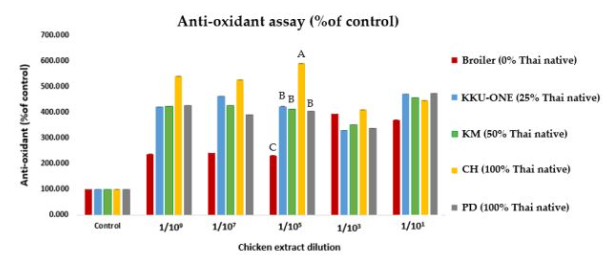
Carnosine and Anserine as Ergogenic Aids
-
Carnosine is a natural dipeptide composed of β-alanine and L-histidine. It functions as an antioxidant and a physiological buffer in muscle tissue, helping to offset the production of hydrogen ions (H+) during intense exercise, which can delay the onset of muscle fatigue.
-
Anserine, another histidine-containing dipeptide (HCD), often found in conjunction with carnosine in humans and poultry, shares similar buffering properties to carnosine.
-
The combination of carnosine and anserine can be particularly effective in buffering blood lactate concentrations during high-intensity activities, which is crucial for sports like soccer where repeated sprints are common.
Practical Applications and Limitations
-
Chicken Broth as a Functional Food: Chicken broth, rich in carnosine and anserine, has been shown to improve power output in high-intensity cycling time trials, making it a potential pre-exercise supplement. However, the practical challenge is the need to consume approximately 600 ml of broth before exercise, which might not be convenient for everyone.When using a chicken breast extract, aim for at least 4 grams, but highly dependent on the content and unclear from the studies.
-
Beta-Alanine Supplementation: To increase muscle carnosine levels, β-alanine supplementation is recommended at doses of 3.2 to 6.4 g per day for 4 to 8 weeks, with peak effects at 10 to 12 weeks. After this period, supplementation can either be paused for 10 to 15 weeks or maintained with a lower daily dose (~1.6 g per day).
-
Paresthesia: A common side effect of β-alanine supplementation is paresthesia, a tingling sensation that can occur at doses starting from 800 mg. While not harmful, it can be uncomfortable. To manage this, doses can be spread throughout the day or a sustained-release formulation can be used to minimize the sensation.
Efficacy and Usage
- High-Quality Evidence: The effectiveness of β-alanine in enhancing performance is well-supported, with evidence comparable to that for creatine. It is recognized and approved by sports federations worldwide.
In summary, the combination of carnosine and anserine can enhance exercise performance by buffering hydrogen ions and delaying muscle fatigue. While chicken broth is a natural source, β-alanine supplementation offers a more practical and effective way to achieve these benefits, albeit with the consideration of managing potential paresthesia.
✅ To increase muscle carnosine levels, β-alanine supplementation is recommended at doses of 3.2 to 6.4 g per day for 4 to 8 weeks, with peak effects at 10 to 12 weeks. After this period, supplementation can either be paused for 10 to 15 weeks or maintained with a lower daily dose (~1.6 g per day).
A fragmented dose adjusted to the individual's weight might be optimal, namely, a combination of a fixed 800 mg dose plus an additional 10 mg/kg of body weight per day. (doi: 10.3390/nu11122869). So for a 74 kg individual, this would equal 3-4 daily doses of 1.5 grams per dose for the loading phase followed by a 1.5g maintenance dose.
✅ While the evidence is low, doing a chronic intake of a few grams of beta-alanine might eliminate the need to do a loading phase on higher dosages. We could certainly see this in light of smaller meat consumption in the modern age. It’s not very clear what should happen after the maintenance phase, theoretically, one weans off for a few weeks to offset habituation before entering the loading phase again to repeat a cycle. I have not seen evidence for this approach in the literature though. If you’re after the maximal ergogenic effect, do the cycling thing, otherwise just take 2-3 grams chronically, benefiting from the health effects and probably the ergogenic effects too. It’s not clear to me why habituation would set in for a biological buffering substance.
✅ Consume chicken breast 2,5 - 3 hours before performance for an ergogenic effect. The food-based combination of histidine dipeptides like carnosine, anserine, and balenine in chicken can reasonably be assumed to have superior buffering capacity than beta-alanine supplements. Might add some chicken breast extract.
✅ Histidine dipeptides are species-specific, and in humans, human muscles tend to have carnosine, anserine, and balenine. It can be argued that taking a mix of them would be superior to beta-alanine or carnosine alone. This appears to be the case (2) in experimental research. However, such mixes are not available on the market (yet). Another reason why a food-based approach might be warranted.
✅ Human health profits from both the endogenous histidine-dipeptides in muscle mass, as from dietary sources and supplements. All should be implemented in BIOS.
✅ If slow-release beta-alanine is too expensive for users, one could opt to take the baseline fixed amount from the fragmented approach (800mg), which conveniently doesn’t cause the tingling sensation, and add the remainder as a slow-release tab.
(1) Alonso, M. R., & Fernández-García, B. (2020). Evolution of the use of sports supplements. PharmaNutrition, 14, 100239. doi:10.1016/j.phanu.2020.100239
(2) Blancquaert, L., Everaert, I., Baguet, A., Barbaresi, S., de Jager, S., Stautemas, J., ... & Derave, W. (2019). Acute carnosine and anserine supplementation as a novel ergogenic strategy for high-intensity exercise. In 24th Annual congress of the European College of Sport Science (ECSS Prague 2019).
Bicarbonate (draft)
Bicarbonate supplementation has long been recognized as a valuable tool for enhancing performance in high-intensity sports (1), where short bursts of energy are crucial. Its primary benefit lies in its ability to buffer hydrogen ions produced during anaerobic metabolism, which helps delay muscle fatigue and maintain force production.
Historically, athletes have used bicarbonate since the late 19th century to increase muscle buffering capacity, thereby improving performance in activities like sprints. The traditional approach involved taking a single dose of 300 mg per kilogram of body weight about three hours before the competition. This method was effective but has evolved as new research emerged.
More recent recommendations suggest a more sustained approach to bicarbonate supplementation. Athletes are now advised to take 400 mg per kilogram per day for five to seven days, followed by a maintenance dose of 2 grams per day for a month. This chronic dosing strategy not only enhances buffering capacity but also brings additional benefits, such as better potassium regulation, increased mitochondrial biogenesis, and improved cardiac function. These physiological changes contribute to overall better performance in various sports.
The idea of using bicarbonate to create a state of alkalosis, where the body's pH is slightly elevated, is beneficial because it helps manage acid accumulation in muscles during intense exercise. This leads to sustained performance levels and quicker recovery.
While there's been a lot of talk about "alkaline diets" in recent years, which claim to boost athletic performance by altering body pH through specific foods, there isn't strong evidence to support these claims. The benefits of bicarbonate are specific to its role as a buffering agent and aren't necessarily tied to diet alone.
For athletes aiming to enhance their performance in anaerobic sports, a well-structured bicarbonate supplementation plan could be highly effective. Starting with a higher dose over several days and then maintaining a lower daily dose can improve the body's ability to manage acid buildup during intense exercise. However, it's important to note that bicarbonate can sometimes cause gastrointestinal discomfort, so it's wise to test the dosing strategy during training before relying on it in competition.
✅ On BIOS we do things a little differently, instead of mega-dosing bicarbonates before exercise, we keep pH levels chronically between 7.5 and 8.5 as measured by urinary pH. One could combine urinary and salivary measures too.
I believe that it is the homeostatic range that boasts the observed health and ergogenic benefits and not some kind of arbitrary acute high dose. What is probably happening is that most people suffer from mild chronic metabolic acidosis due to a shortage of bicarbonates in the diet and thus need a mega dose to reach a proper range in a very short amount of time (match day).
✅ On BIOS we use gastric juice-resistant tablets of sodium or potassium bicarbonate, the chemical reaction between bicarbonates and stomach acid creates a gas, which might rupture the stomach wall when taking too much. On the other hand, daily use of bicarbonates that come into contact with gastric juice would lower the pH in the stomach and invite infections.
✅ On BIOS taking 2 grams of regular (non-gastric juice resistant) sodium bicarbonate (baking soda dissolved in water) first thing in the morning on an empty stomach is permitted, maybe once a week at maximum. This triggers the vagus nerve and activates an anti-inflammatory response that can benefit systemic health.
(1) Alonso, M. R., & Fernández-García, B. (2020). Evolution of the use of sports supplements. PharmaNutrition, 14, 100239. doi:10.1016/j.phanu.2020.100239
Caffeine
Caffeine, isolated from coffee in 1821, has a rich history (1) that spans across various cultures and centuries. Its use as a stimulant dates back to ancient times, with records showing that the Chinese emperor Shen Nung consumed tea infusions around 2737 BC. Similarly, coffee became a popular beverage in Arabic cultures, eventually spreading worldwide through various forms like roasted coffee beans and yerba mate. Even today, caffeine remains a widely used stimulant, particularly among athletes who consume it in different preparations to enhance performance.
Caffeine's role in sports has evolved significantly, largely due to advances in understanding its mechanisms of action. In the late 1980s, anti-doping agencies included caffeine on their list of prohibited substances due to its performance-enhancing effects at high doses. However, in 2003, caffeine was removed from the Prohibited List and is now part of the World Anti-Doping Agency's Monitoring Program, recognizing its common presence in beverages and its safe use at typical consumption levels.
Initially, caffeine's ergogenic effects were observed at high doses of 6-9 mg per kilogram of body weight. However, more recent research has shown that much lower doses, as low as 1-2 mg/kg, can also be effective, particularly for enhancing cognitive function, which is beneficial for sports performance. These lower doses are especially useful in combating mental fatigue, making caffeine a versatile tool for athletes across various sports.
Additionally, research has shown that genetic variations, particularly in the CYP1A2 and ADORA2A genes, can influence how individuals respond to caffeine. This suggests that considering an athlete's genetic background might be important when deciding whether to use caffeine as a performance-enhancing supplement.
In summary, caffeine's journey from a traditional stimulant to a well-studied ergogenic aid reflects both its enduring popularity and the ongoing advancements in sports science. With its ability to enhance both physical and mental performance, caffeine remains a valuable supplement for athletes, though individual responses can vary based on genetic factors.
(1) Alonso, M. R., & Fernández-García, B. (2020). Evolution of the use of sports supplements. PharmaNutrition, 14, 100239. doi:10.1016/j.phanu.2020.100239
Carbohydrates
The significance of carbohydrates (CHO) in athletic performance began to gain recognition in the 1930s when scientists linked carbohydrate consumption to exercise capacity and the prevention of hypoglycemia (1). This understanding deepened in the 1960s, thanks to Scandinavian researchers who used muscle biopsy techniques to study muscle metabolism during exercise. These studies revealed that intense and sustained workouts deplete muscle glycogen stores, leading to the development of nutritional strategies that emphasize the importance of supplementing carbohydrates before, during, and after exercise.
Carbohydrates, especially glucose, soon became a staple in sports nutrition, particularly for events lasting longer than four minutes. The 1950s saw the emergence of carbohydrate pills, bars, and later, gels. Before the advent of commercial sports drinks, athletes would often make homemade beverages based on oral rehydration solutions, a practice that laid the groundwork for products like Gatorade. Developed by scientists at the University of Florida for the Florida Gators athletic teams, Gatorade became the first commercially successful sports drink.
In the 1990s, athletes were advised to consume 60-70% of their total energy intake from carbohydrates to maintain glycogen stores and optimize performance during high-intensity activities. However, studies found that many athletes struggled to meet this intake level without apparent performance deficits, leading to more precise recommendations. These new guidelines suggest carbohydrate intake should be tailored to the intensity of the exercise performed, expressed in grams of CHO per kilogram of body weight. Depending on the demands of the activity, recommendations can range from 6-10 g/kg/day to 12-14 g/kg/day for the most strenuous exercise.
Over time, the approach to carbohydrate supplementation has evolved. Research revealed that combining different sugars—such as glucose with fructose or sucrose—enhances carbohydrate absorption in the intestines. This combination can increase the absorption rate from 1.1 g/kg/h to 1.8 g/kg/h, optimizing the availability of energy during exercise. Additionally, studies have shown that even rinsing the mouth with a carbohydrate solution can improve performance, highlighting the versatile role of carbohydrates in sports nutrition.
The glycemic index (GI) of foods also became a topic of interest, as it was thought that high-GI foods might accelerate recovery due to faster absorption. However, research indicated no significant difference in recovery between high- and low-GI foods. Despite this, high-GI supplements are commonly used during exercise, though they can cause rebound hypoglycemia if consumed before physical activity.
The approach to using carbohydrates for performance optimization has oscillated between natural foods, processed foods, and various supplements like sweets and even jellybeans. Recreational athletes have adopted similar carbohydrate consumption habits as high-performance athletes, often without the same energy demands, raising questions about the long-term health implications of such practices.
(1) Alonso, M. R., & Fernández-García, B. (2020). Evolution of the use of sports supplements. PharmaNutrition, 14, 100239. doi:10.1016/j.phanu.2020.100239
Creatine
Creatine, a compound first identified in 1832 by Chevreul, derives its name from the Greek word for meat, "κρέας" (kreas), reflecting its origin in meat (1). Early research in the mid-20th century linked creatine metabolism to aging, but it wasn't until the 1970s that it gained attention as a potential performance enhancer, particularly among athletes in the USSR. The breakthrough came in 1992 when Harris and colleagues demonstrated that creatine supplementation could increase creatine levels in muscles without altering ATP content. This discovery was pivotal, as it suggested that creatine could enhance muscle performance, particularly during short, high-intensity activities.
In 1993, Greenhaff and his team showed that creatine supplementation could increase peak torque during intermittent exercise, highlighting its ability to improve strength in fast-twitch muscle fibers. These findings spurred a wave of research, cementing creatine's reputation as a powerful ergogenic aid. Its popularity soared in the 1990s, especially after high-profile athletes like Linford Christie, the 100-meter gold medalist at the 1992 Olympics, publicly endorsed it. This led to the widespread adoption of creatine among speed and power athletes.
Initially, creatine was primarily used to enhance short-term, high-intensity sports activities. However, its use has since expanded to endurance athletes who incorporate it into their training regimens for high-intensity aerobic exercise. Further research shifted focus from creatine's role in energy supplementation to its potential effects on muscle anabolism, revealing its broader benefits beyond just performance enhancement.
In recent years, the understanding of creatine's mechanisms has expanded further, showing promise in treating conditions like sarcopenia (muscle loss associated with aging) and even improving cognitive functions. These discoveries have led to creatine's use among not just athletes but also the general population, including older adults looking to maintain muscle mass and cognitive health.
The recommended dosing strategy for creatine has evolved over time. Initially, a loading phase of 20 grams per day for several days was common to achieve rapid increases in muscle creatine levels. For maintenance or therapeutic purposes, lower doses ranging from 0.3 g/kg/day to 0.03 g/kg/day are often used. Combining creatine with carbohydrates has been shown to improve absorption, influencing the formulation of many creatine supplements available today.
As a result of these developments, creatine has become one of the most widely consumed nutritional supplements globally, not only in sports but also for its potential health benefits in various populations.
(1) Alonso, M. R., & Fernández-García, B. (2020). Evolution of the use of sports supplements. PharmaNutrition, 14, 100239. doi:10.1016/j.phanu.2020.100239
Iron
Iron is one of the most commonly used sports supplements worldwide due to its critical role in maintaining hemoglobin levels and facilitating oxygen transport in the blood (1). It is well-established that athletes often have lower iron levels compared to non-athletes. This is partly due to the unique metabolic demands placed on athletes, which include lower absorption and higher elimination rates of iron. Female athletes are particularly at risk of iron deficiency and anemia due to menstrual blood loss.
The general recommended daily intake of iron is 15 mg, primarily sourced from the diet. Foods rich in iron include red meat, liver, and fish, but it's not just the quantity of iron in these foods that matters—bioavailability plays a crucial role. Ferritin, a protein that stores iron in cells, is typically used as a marker to guide iron supplementation. Clinical guidelines suggest supplementation when plasma ferritin levels drop below 15 mcg/ml. However, ferritin also acts as an inflammatory marker that can respond to physical stress, complicating its use as a sole indicator of iron status.
Despite efforts to maintain adequate iron levels through diet, many athletes—especially those with high training loads—often require additional iron supplementation. Endurance athletes, in particular, tend to maintain iron supplementation throughout the season to keep up with their increased demands. To manage iron levels, team physicians regularly monitor hematological parameters, including red blood cells, hemoglobin, ferritin, transferrin, and serum iron, while taking into account other factors that might influence these values.
Special attention is required for athletes who train or compete at high altitudes, where the demand for iron increases due to the need for elevated hemoglobin mass. In these cases, iron levels should be carefully managed and monitored well before altitude training begins.
Oral iron therapy is generally effective, except in situations where hepcidin levels are high, such as during inflammation. Hepcidin is a hormone that regulates iron absorption by controlling ferroportin, a transmembrane iron transporter. Athletes with high hepcidin levels may require a personalized approach to iron supplementation, as they may be resistant to standard treatments.
Genetic factors also play a significant role in iron metabolism. For instance, athletes with mutations in the HFE gene, which is associated with a high VO2 max, may have an increased prevalence of this mutation. However, these mutations are also linked to hemochromatosis, a condition where iron overload occurs, making iron supplementation contraindicated for these individuals.
The food industry has responded to the need for better iron supplementation by developing various iron-fortified products. These often include innovations like combining iron with ascorbic acid to enhance absorption or using liposome technology to improve bioavailability. Despite these advancements, many nutritionists still prefer medical-grade iron supplements, which contain significantly higher doses of iron than those found in standard sports supplements.
In summary, managing iron levels in athletes requires a comprehensive approach that includes regular monitoring, personalized supplementation strategies, and consideration of both dietary sources and genetic factors. This is particularly important for athletes who engage in high-intensity training, compete at altitude, or are at risk of iron deficiency due to other physiological factors.
(1) Alonso, M. R., & Fernández-García, B. (2020). Evolution of the use of sports supplements. PharmaNutrition, 14, 100239. doi:10.1016/j.phanu.2020.100239
Betalains
Beetroot juice has gained popularity as a natural food supplement, especially for athletes seeking to enhance their endurance and recovery. This is largely due to its rich content of phytochemical compounds, notably nitrates, and betalains, which offer a range of health and performance benefits.
Nitrate, one of the key components of beetroot juice, is well-documented for its ability to improve exercise performance. It works by enhancing the efficiency of mitochondria, the energy powerhouses of cells, and increasing nitric oxide levels in the blood. This leads to better blood flow and oxygen delivery to muscles during exercise, thereby boosting endurance and performance.
Betalains, the pigments responsible for the deep red color of beetroot, also offer significant benefits. These bioactive compounds exhibit strong antioxidant, anti-inflammatory, and anti-hypertensive properties. During and after strenuous exercise, betalains can help mitigate the negative effects of prolonged physical exertion, such as muscle damage, inflammation, and fatigue. By scavenging free radicals, betalains not only protect against oxidative stress but may also enhance nitric oxide availability, further improving blood flow and oxygenation during exercise.
Nirmal, S., Olatunde, O. O., Medhe, S., Vitti, S., Khemtong, C., & Nirmal, N. P. (2023). Betalains Alleviate Exercise-Induced Oxidative Stress, Inflammation, and Fatigue and Improve Sports Performance: an Update on Recent Advancement. Current Nutrition Reports, 12(4), 778-787.
Citrulline Malate not L-Arginine
What might soon be known (1) as "the non-essential amino acid that could cure COVID-19". L-arginine seems to be able to prevent mortality in people who are more or less dying from the condition. (NO+glutathione =Nitrosoglutathione, a bronchodilator).
Yet, unless you're nearly death with severe L-Arginine deficiency, I would not supplement with it (in healthy individuals) because of the risk of bleeding incidents. Supplementing with another nonessential amino acid called Citrulline seems to be a safer option. We might as well use the Citrulline Malate form which delivers two beneficial and ergogenic substances at once, citruline and malate.
A citrulline malate dose of 8-12g taken before exercise is most beneficial for measures of athletic performance. L-citrulline supplementation significantly increases plasma L-arginine levels, considered safe (3-month trials), I could not find adverse case reports as with arginine. Just to be sure and safe, I am going to recommend Citruline Malate only for people above 25-30 years old and Arginine only when you're already half dead. Nocturnal penile tumescence (morning wood) is a clear sign that the supplements have clinical benefits in blood flow.
Could add a microdose of dietary level arginine amounts to this if required at your own risk. The canonical nitric oxide pathway (arginine pathway) does indeed decline during aging. Citruline malate can increase strength, and performance, reduce muscle soreness during and after exercise, improve blood flow through raised nitric oxide levels, and can increase the number of repetitions to fatigue. While the citrulline raises NO levels, the malate contributes to the Krebs cycle and possibly enhances mitochondrial function.
✅ L-Arginine may still be useful in critical, life-threatening situations where NO levels are severely depleted, but its use should be carefully monitored
✅ Microdose arginine during the aging process
✅ Use 8-10 grams of citrulline malate 20-40 minutes before exercise to enhance performance
(1) Fiorentino, G., Coppola, A., Izzo, R., Annunziata, A., Bernardo, M., Lombardi, A., ... & Trimarco, B. (2021). Effects of adding L-arginine orally to standard therapy in patients with COVID-19: A randomized, double-blind, placebo-controlled, parallel-group trial. Results of the first interim analysis. EClinicalMedicine, 40.